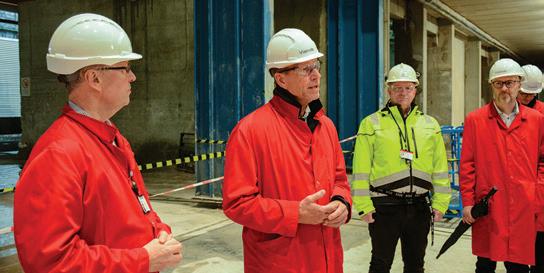
3 minute read
Farm Advisory Service
attract the big gigafactories,” says Terje Aasland, Norway’s Minister of Petroleum and Energy.
The industrial plant at Herøya, Norway, will produce anode graphite for about 20,000 electric vehicles (EVs) per year by 2024. This investment is the first phase in a larger investment plan. The plant construction will be carried out in parallel with preparations for a second phase plant scaled to provide battery materials to 2 million EVs per year by 2030, covering a significant share of the global EV market.
Advertisement
“The establishment of an industrial-scale plant for sustainable battery materials at Herøya represents a historic step for Vianode and its owners. Based on strong support from owners Elkem, Hydro and Altor, Vianode has a solid foundation to succeed with building industrial leadership in advanced battery materials with a green footprint. To succeed in Norway requires competitive framework conditions, and in that context we appreciate today’s visit to learn more about our activities and plans,” says Asbjørn Søvik, Vianode’s interim CEO and executive chair of the board.
The graphite materials from Vianode are produced with up to 90 percent lower CO2 emissions than today’s standard materials. The materials have unique performance characteristics and improve the properties in batteries, including faster charging, increased range and longer service life, as well as increased safety and recyclability.
Hills across the UK can be transformed into renewable energy “batteries”
RheEnergise, a UK clean technology company, wants to partner farmers across the UK to deploy their pioneering hydropower-like energy storage system, alongside their existing or future renewable energy assets, such as wind and solar farms. By doing so, RheEnergise offers farmers greater energy security and a new long-term source of income. RheEnergise has developed a system that adapts one of the oldest forms of energy storage, hydropower, to store and release electricity from slopes rather than requiring steep dam walls and mountains. It means that there are thousands of potential hydropower sites across the UK that could be used for energy storage – as many as 6,500 sites, according to the company’s own analysis.
RheEnergise’s development of its technology has received grant support from the UK and Canadian governments and is shortly to commence a crowdfunding campaign via the Crowdcube platform.
For further information, please visit www.rheenergise.com / twitter @rheenergise

Plan now to navigate your way through the tough times ahead
Rising costs are putting pressure on many farming businesses. Typical warning signs include overdrafts and credit accounts creeping upwards with difficulties meeting regular payments.
The preparation of a simple cashflow can go a long way to identifying any future issues.
Take the time to list future cash inflows including: • Future sales of stock and crops. • VAT receipts, subsidies and asset sales. • Off-farm or other income sources. • Any outstanding sales which have yet to paid.
When listing outgoings, consider: • Current invoices unpaid or not yet received. • Future input and trading expenditure. • VAT or tax liabilities. • Hire purchase and loan repayments and interest. • Household bills, or drawings paid by the business.
The cashflow projection can then be mapped out, allocating each item of income and expenditure across the months ahead using a simple spreadsheet, or table. Using the current bank balance as a starting point, peaks and troughs will be shown, highlighting the problem periods. Key areas to consider: • Matching expenditure with projected income. • Can sales be brought forward, or can purchases and payments be delayed? • Do loan and finance payment match cash inflow?
Talking is key - speak early to suppliers and lenders about tailoring payments to a more appropriate time for the business.
Is the lack of cash purely down to timing? If there is an overall deficit, is the spike in input prices merely a temporary blip to an inherently profitable business or are there deeper fundamental issues at play? Deficits need to be addressed at some point to ensure there is adequate working capital going forward. Drilling down to find the root causes of why cash is tight is key to looking at potential solutions in the short and long term.










